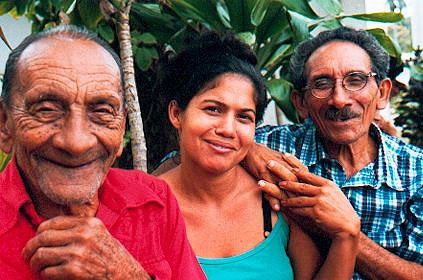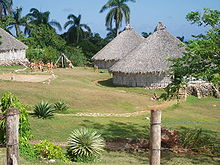 DESCENDIENTE DE INDIOS TAÍNOS CUBANOS REGRESAN A SUS ORÍGENES.
DESCENDIENTE DE INDIOS TAÍNOS CUBANOS REGRESAN A SUS ORÍGENES.
En la serranía de Yateras, en el oriente de Cuba, hay una comunidad que conserva las raíces originarias de la población cubana. Son descendientes de taínos.
Aproximadamente hacia el año 1970 se iniciaron los estudios genéticos en Cuba para describir el origen del ADN de nuestra población con rigor científico. Después de muchos años de trabajo, las investigaciones permitieron obtener información de unas 15 generaciones anteriores a la persona estudiada, lo que se traduce en un viaje a través de 500 años de historia.
En una entrevista realizada por la Revista Digital Cubahora, a la Dra. C. Beatriz Marcheco Teruelo, directora del Centro de Genética Médica de Cuba, esta científica expone que: “ Las provincias que más altos porcentajes tienen en su información genética de genes ancestrales procedentes de las poblaciones indoamericanas son: Las Tunas (13 %), Granma, Holguín y Guantánamo… El promedio de genes de esa procedencia en el oriente de Cuba es de un 10 %, el más alto del país.”
EL PATRIMONIO ABORIGEN.
El interés por investigar la raíz india en Cuba es mucho más antiguo de lo que solemos pensar. Se han adentrado en estos estudios antropólogos, etnólogos e historiadores desde los inicios del siglo XX. Uno de los casos más mediáticos fue el del arqueólogo norteamericano Mark Raymond Harrington (1882-1971) quien visitó en varias ocasiones la isla entre 1910 y 1920. Este investigador fue autorizado por los gobiernos de turno a extraer importantes piezas para someterlas a análisis en Estados Unidos. Fue así como terminaron en los almacenes del National Museum of the American Indian (NMAI) alrededor de cinco mil piezas, entre las que figura el Tótem o Ídolo de Patana (1915) que aún no ha sido devuelto a Cuba, o los restos de siete indocubanos taínos, de ellos seis adultos y una menor, que fueron repatriados en el año 2003 casi un siglo después de su sustracción en la región de Maisí.
El objetivo de estos estudios científicos puede haber sido loable, pero se convirtieron en una pérdida irreparable para la antropología y la arqueología cubana. Esto se debe a que no solo se extrajeron del país importantes objetos, sino que para sacar algunas de estas piezas fue necesario fragmentarlas, como es el caso del ‘Tótem de Patana’, que fue dividido por Harrington en cinco partes. Actualmente se expone en el NMAI, que pertenece al Instituto Smithsoniano y está ubicado en Nueva York, Estados Unidos.
El Tótem de Patana era una talla aborigen realizada en una estalagmita. Fue hallada por Harrington en una cueva de Maisí. La figura tallada era un dios taíno, del cual se conserva una imagen similar, pero en madera de Guayacán Negro y que afortunadamente no corrió la misma suerte que el de Patana. Esta figura se conoce como el Cemí de Gran Tierra, o Ídolo del Tabaco por su parecido con un gigantesco tabaco cubano. Actualmente se expone en el Museo Antropológico Dr. Luis Montané, en la Universidad de La Habana.
Francisco Ramírez, más conocido como “El Cacique Panchito”, es el líder de La Ranchería, una pequeña comunidad en las montañas cubanas de la provincia Guantánamo. Este poblado pertenece al Consejo Popular La Caridad de los Indios, un asentamiento humilde cuya actividad económica fundamental es la agricultura y la ganadería menor.
Tras su larga estancia en las salas de exposición del Museo del Indio Americano en Estados Unidos, en el año 2003 fueron devueltos los restos de los siete taínos. Se eligió el pequeño cementerio de la comunidad La Ranchería, de La Caridad de los Indios, como sitio de enterramiento. En la decisión tuvo un peso singular la razón de ser quizás el lugar donde se conservan en su expresión más autóctona las tradiciones, cantos, comidas y prácticas aborígenes cubanas.
El Cacique Panchito ofició el sepelio y con ello cumplió su anhelo de reunificación. Realizó un solemne ritual que inició solicitando permiso a las mujeres y hombres mayores. Evocó en su lenguaje sencillo el valor de la historia y las tradiciones. Y acompañó la ceremonia con humo de tabaco, mientras clamaba una oración a las cuatro direcciones (Estaciones) y se entonaban posteriormente las notas de “La Mamalina”, un canto que es símbolo de tradición y mensaje espiritual.
Lo intrincado de La Ranchería hace que pocas personas se hayan aventurado a visitarla. Quizás gracias a eso, esta población ha conservado sus raíces a pesar del profundo mestizaje de nuestra Isla.
 DESCENDANTS OF CUBAN TAINO INDIANS RETURN TO THEIR ORIGINS.
DESCENDANTS OF CUBAN TAINO INDIANS RETURN TO THEIR ORIGINS.
In the mountainous area of Yateras, in eastern Cuba, there is a community that conserves the original roots of the Cuban population. They are descendants of the Tainos.
Around the year 1970, genetic studies were initiated in Cuba to describe the origin of the DNA of our population with scientific rigor. After many years of work, the investigations allowed to obtain information from some 15 generations prior to the person studied, which translates into a journey through 500 years of history.
In an interview conducted by Digital Magazine Cubahora, Dr. C. Beatriz Marcheco Teruelo, director of the Center for Medical Genetics of Cuba, this scientist states that: “The provinces that have higher percentages in their genetic information of ancestral genes from of the Indo-American populations are: Las Tunas (13%), Granma, Holguín and Guantanamo … The average of genes from that source in eastern Cuba is 10%, the highest in the country. ”
THE HERITAGE ABORIGIN.
The interest in investigating the Indian root in Cuba is much older than we usually think. Anthropologists, ethnologists and historians have gone into these studies since the beginning of the 20th century. One of the most mediatic cases was that of the North American archaeologist Mark Raymond Harrington (1882-1971) who visited the island several times between 1910 and 1920. This researcher was authorized by the governments in turn to extract important pieces for analysis in the United States. United. This is how they ended up in the warehouses of the National Museum of the American Indian (NMAI) around five thousand pieces, among which is the Totem or Idol of Patana (1915) that has not yet been returned to Cuba, or the remains of seven Taíno Indo-Cubans, six of them adults and one minor, who were repatriated in 2003 almost a century after their abduction in the region of Maisí.
The objective of these scientific studies may have been praiseworthy, but they became an irreparable loss for Cuban anthropology and archeology. This is because not only important objects were extracted from the country, but to extract some of these pieces it was necessary to fragment them, as is the case of the ‘Totem of Patana’, which was divided by Harrington into five parts. It is currently exhibited at the NMAI, which belongs to the Smithsonian Institute and is located in New York, United States.
Patana’s Totem was an aboriginal carving done in a stalagmite. It was found by Harrington in a cave in Maisi. The carved figure was a Taíno god, of which a similar image is conserved, but in wood of Guayacán Negro and that fortunately did not have the same luck that the one of Patana. This figure is known as the Cemí de Gran Tierra, or Idol of Tobacco for its resemblance to a gigantic Cuban cigar. Currently it is exhibited at the Dr. Luis Montané Anthropological Museum, at the University of Havana.
Francisco Ramírez, better known as “El Cacique Panchito”, is the leader of La Ranchería, a small community in the Cuban mountains of Guantanamo province. This town belongs to the Popular Council La Caridad de los Indios, a humble settlement whose fundamental economic activity is agriculture and small livestock.
After his long stay in the exhibition halls of the Museum of the American Indian in the United States, in 2003 the remains of the seven Tainos were returned. The small cemetery of the La Ranchería community, of La Caridad de los Indios, was chosen as a burial site. In the decision, the reason for being perhaps the place where the traditions, songs, foods and Cuban aboriginal practices are preserved in their most indigenous expression had a singular weight.
Cacique Panchito officiated at the funeral and with this he fulfilled his desire for reunification. He performed a solemn ritual that began asking permission to women and older men. He evoked in his simple language the value of history and traditions. And he accompanied the ceremony with tobacco smoke, while clamoring a prayer to the four directions (Stations) and then intoned the notes of “La Mamalina”, a song that is a symbol of tradition and spiritual message.
The intricacy of La Ranchería means that few people have ventured to visit it. Perhaps thanks to that, this population has conserved its roots in spite of the deep miscegenation of our Island.
Agencies/CiberCuba/ Gretchen Schez/ Internet Photos/ Arnoldo Varona/ www.TheCubanHistory.com
THE CUBAN HISTORY, HOLLYWOOD.









